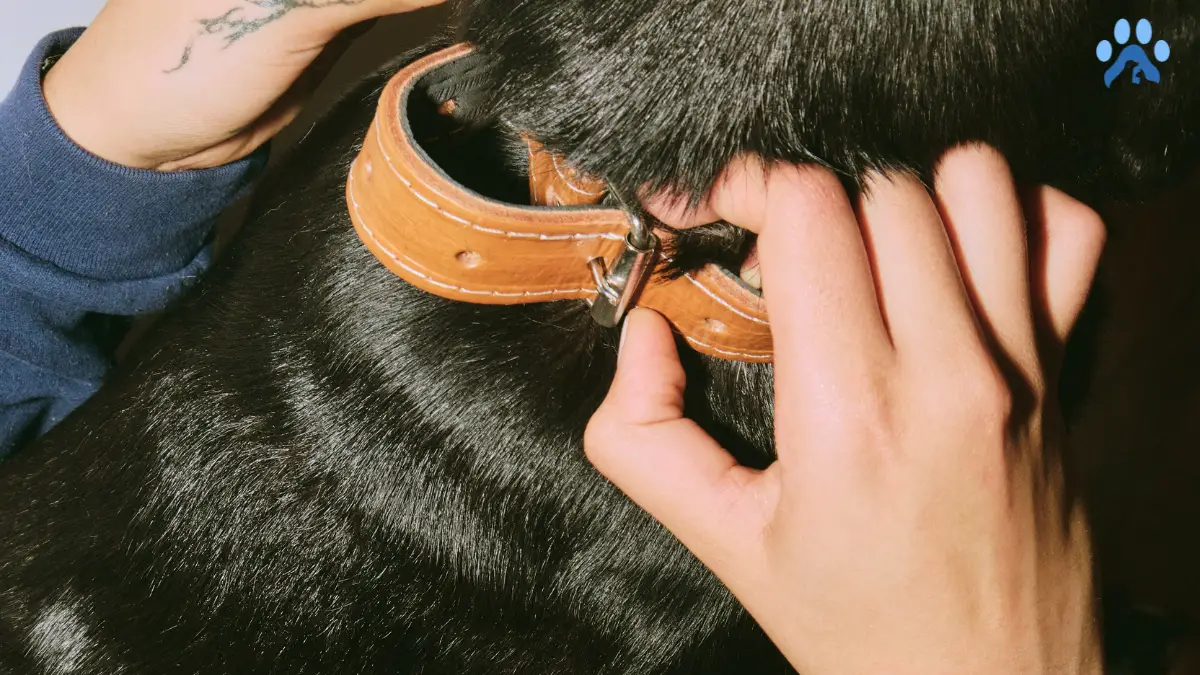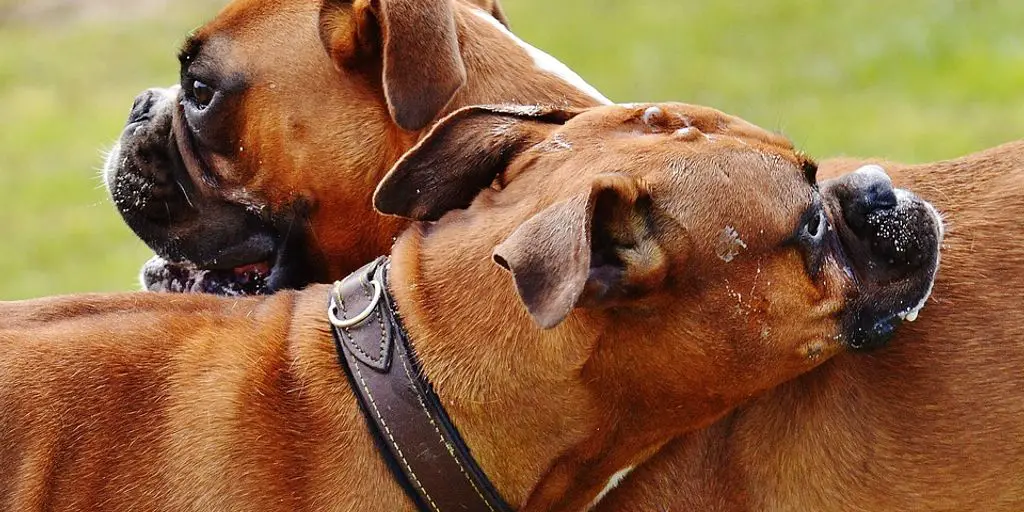Training a dog to wear a collar is an essential part of being a responsible pet owner. A collar is not only a fashion accessory for your dog, but it also serves as a means of identification and a way to keep them safe. However, some dogs may resist wearing a collar, making it challenging to train them.
The key to training your dog to wear a collar is to introduce it slowly and positively. Start by allowing your dog to sniff and investigate the collar before putting it on. Once they seem comfortable with the collar, attach it loosely around their neck for short periods, gradually increasing the time they wear it. Positive reinforcement, such as treats and praise, can also help your dog associate the collar with positive experiences.
It’s important to note that some dogs may have a negative association with collars due to past experiences or trauma. In these cases, it’s best to seek the help of a professional dog trainer who can use positive reinforcement techniques to help your dog overcome their fear of wearing a collar. With patience and consistency, your dog can learn to wear a collar comfortably and happily.
Why Training Your Dog to Wear a Collar is Important
Training your dog to wear a collar is an essential part of responsible dog ownership. A collar serves as a means of identification, allowing you to find your dog if they get lost. It also provides a way to control your dog while walking and in other situations. Here are some reasons why training your dog to wear a collar is important:
- Identification: A collar with an ID tag is the best way to ensure that your lost dog can be easily identified and returned to you. It is important to make sure that the ID tag has your current contact information, including your name, phone number, and address.
- Control: A collar is an essential tool for controlling your dog while walking. A well-fitted collar allows you to attach a leash, giving you the ability to guide your dog and keep them safe. This is especially important in busy areas or near traffic.
- Training: Training your dog to wear a collar is an important part of dog training. It teaches your dog to be comfortable with wearing a collar and allows you to introduce them to other training tools, such as a leash.
- Safety: A collar can also be an important safety tool. It allows you to attach an ID tag with your contact information, making it easy for someone to contact you if your dog gets lost. A collar can also be used to attach a reflective strip or light, making your dog more visible in low-light conditions.
- Legal Requirements: In many areas, it is a legal requirement for dogs to wear a collar with an ID tag. Failure to comply with these requirements can result in fines or other penalties.
Training your puppy to wear a collar is an important part of early socialization. It teaches your puppy to be comfortable with wearing a collar and allows you to introduce them to other training tools, such as a leash. It is important to start training your puppy to wear a collar as early as possible, ideally when they are still young.
In summary, training your dog to wear a collar is an important part of responsible dog ownership. It provides a means of identification, allows you to control your dog while walking, and is an important safety tool. It is also a legal requirement in many areas.
Choosing the Right Collar for Your Dog
When it comes to choosing a collar for your dog, there are several factors to consider, including the type of collar, the fit, and whether or not to add an ID tag.
Different Types of Collars
There are several different types of collars available for dogs, each with its benefits and drawbacks. Some of the most popular types of collars include:
- Flat-buckle collars: These simple collars buckle or snap closed and are the most popular choice for everyday use. They come in a range of sizes and materials and are suitable for most dogs.
- Martingale collars: Also known as limited-slip collars, these collars are designed for dogs that tend to pull or slip out of their collars. They tighten slightly when the dog pulls, preventing them from escaping.
- Body harnesses: These collars wrap around the dog’s chest and are a good option for dogs that tend to pull on their leash. They distribute pressure more evenly than traditional collars and can be a good choice for dogs with respiratory issues.
- Choke chains and prong collars: These collars are designed to tighten around the dog’s neck when they pull, causing discomfort and discouraging pulling. However, they can be dangerous if not used correctly and are not recommended for most dogs.
- Shock collars: These collars deliver an electric shock to the dog when they misbehave. They are controversial and should only be used as a last resort.
Collar Fit
It’s important to ensure that your dog’s collar fits properly. A collar that is too loose can slip off, while a collar that is too tight can be uncomfortable or even cause injury. To ensure a proper fit, you should be able to fit two fingers between the collar and your dog’s neck. You should also check the fit regularly, as dogs can gain or lose weight over time.
Adding an ID Tag
In addition to choosing the right collar, it’s also important to add an ID tag to your dog’s collar. This can help ensure that your dog is returned to you if they become lost. The tag should include your dog’s name, your phone number, and any other relevant information, such as medical conditions or allergies.
Overall, choosing the right collar for your dog is an important decision that can impact their safety and comfort. By considering the different types of collars available, ensuring a proper fit, and adding an ID tag, you can help keep your dog safe and secure while out on walks.
Getting Your Dog Used to Wearing a Collar
When it comes to training a dog to wear a collar, it’s important to start slow and use positive reinforcement techniques. Here are some steps to follow:
Starting with a Comfortable Collar
Before you begin training, make sure you have a comfortable collar that fits your dog properly. A collar that is too tight or too loose can cause discomfort or injury. Choose a collar made of a soft, lightweight material, such as nylon or leather.
Introducing the Collar
Once you have a comfortable collar, introduce it to your dog. Hold the collar out in front of your dog and let him sniff it. Then, place the collar on the ground and let your dog investigate it. This will help him get used to the collar’s smell and texture.
Next, hold the collar in one hand and a treat in the other. When your dog looks at the collar, give him the treat. Repeat this process several times until your dog is comfortable with the collar being near him.
Positive Reinforcement Training
Once your dog is comfortable with the collar, it’s time to start training him to wear it. Start by putting the collar on your dog for short periods, such as during playtime or mealtime.
When your dog is wearing the collar, give him plenty of praise and treats. This will help him associate the collar with positive experiences.
Gradually increase the amount of time your dog wears the collar each day. If your dog seems uncomfortable, remove the collar and try again later.
Remember to always use positive reinforcement techniques when training your dog to wear a collar. With patience and consistency, your dog will get used to wearing a collar in no time.
Training Your Dog to Walk on a Leash with a Collar
Teaching your dog to walk on a leash with a collar can be a challenging task, but with patience and consistency, it can be done. Here are some tips to help you get started.
Teaching Your Dog to Sit and Come
Before you start walking your dog on a leash, it’s important to teach them basic commands like sit and come. This will help you control your dog’s behavior while on the leash. Use treats and positive reinforcement to encourage your dog to obey these commands.
Dealing with Pulling
One of the most common problems when walking a dog on a leash is pulling. If your dog pulls on the leash, stop walking and wait for them to calm down. Don’t move forward until they stop pulling. This will teach your dog that pulling on the leash won’t get them where they want to go.
Using Treats and Toys to Encourage Good Behavior
Using treats and toys can be a great way to encourage good behavior while walking your dog on a leash. Reward your dog with a treat or a toy when they walk calmly on the leash. This will help them associate good behavior with positive rewards.
It’s important to choose the right treats and toys for your dog. Make sure the treats are healthy and not too high in calories. Choose toys that are safe and durable.
In summary, training your dog to walk on a leash with a collar takes time and patience. Use positive reinforcement and rewards to encourage good behavior. Teach your dog basic commands like sit and come before starting to walk on a leash. Deal with pulling by stopping and waiting for your dog to calm down. Use treats and toys to encourage good behavior. With consistent training, your dog will learn to walk on a leash with ease.
Addressing Common Problems with Collar Training
When it comes to collar training, some dogs may experience fear, stress, discomfort, or become easily distracted. As a dog owner, it is important to address these common problems to ensure that your dog is comfortable and happy while wearing a collar and leash.
Dealing with Fear and Stress
Some dogs may be fearful or stressed when it comes to wearing a collar and leash. To address this issue, it is important to introduce the collar and leash slowly and positively. Start by allowing your dog to sniff and investigate the collar and leash before putting it on. Use treats and positive reinforcement to reward your dog for calm behavior.
If your dog continues to exhibit fear or stress, consider consulting with a professional dog trainer who can help you develop a training plan that is tailored to your dog’s specific needs.
Dealing with Discomfort and Distracted Behavior
Some dogs may experience discomfort when wearing a collar and leash, which can lead to distracted behavior. To address this issue, make sure that the collar is properly fitted and not too tight or too loose. It is also important to choose a collar that is comfortable for your dog, such as a padded collar or a collar made from soft materials.
If your dog continues to exhibit distracted behavior, consider using positive reinforcement training techniques to encourage your dog to focus on you while walking on a leash. Use treats and praise to reward good behavior and redirect your dog’s attention if they become distracted.
Troubleshooting Difficulty with Collar Training
If you are having difficulty with collar training, it is important to troubleshoot the issue to determine the root cause. Some common issues that can arise include difficulty with smell, discomfort, or difficulty with walking. Consider consulting with a professional dog trainer who can help you develop a training plan that is tailored to your dog’s specific needs.
Overall, collar training can be a challenging but rewarding experience for both you and your dog. By addressing common problems and utilizing positive reinforcement training techniques, you can help your dog feel comfortable and confident while wearing a collar and leash.
Frequently Asked Questions
How long does it take for a puppy to get used to a collar?
It can take anywhere from a few days to a few weeks for a puppy to get used to wearing a collar. It is important to introduce the collar gradually and positively to help the puppy feel comfortable wearing it. Consistency is key when training a puppy to wear a collar, so make sure to put it on every day for short periods until the puppy is comfortable wearing it for longer periods.
How do you introduce a dog to a collar?
To introduce a dog to a collar, start by letting the dog smell and inspect the collar. Then, put the collar on for a short period, using positive reinforcement such as treats or praise. Gradually increase the amount of time the dog wears the collar until they are comfortable wearing it for longer periods. It is important to make the experience positive and never force the collar on the dog.
Why does my dog hate wearing a collar?
There are a few reasons why a dog may hate wearing a collar. It could be due to a bad experience in the past, discomfort or irritation from the collar, or simply not being used to wearing one. It is important to address the root cause of the issue and work on training the dog to feel comfortable wearing a collar.
How do you put a collar on a dog that doesn’t like it?
If a dog doesn’t like wearing a collar, it is important to take a gradual and positive approach to introducing the collar. Start by letting the dog smell and inspect the collar, and use positive reinforcement such as treats or praise when putting the collar on. Gradually increase the amount of time the dog wears the collar until they are comfortable wearing it for longer periods. If the dog continues to have issues with the collar, it may be necessary to consult a professional dog trainer.
Should puppies wear collars or harnesses?
Puppies can wear either collars or harnesses, depending on their individual needs. Collars are generally used for identification purposes and leash training, while harnesses are often used for dogs that pull on their leash or have respiratory issues. It is important to choose a collar or harness that fits properly and is comfortable for the puppy to wear.



